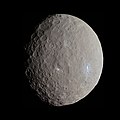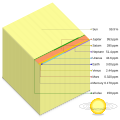A planetary-mass object (PMO), planemo, or planetary body (sometimes referred to as a world) is, by geophysical definition of celestial objects, any celestial...
18 KB (2,000 words) - 13:49, 2 April 2025
A planetary-mass moon is a planetary-mass object. They are large and ellipsoidal (sometimes spherical) in shape. Moons may be in hydrostatic equilibrium...
30 KB (2,332 words) - 01:22, 10 June 2025
Rogue planet (redirect from Interstellar planetary mass object)
free-floating planet (FFP) or an isolated planetary-mass object (iPMO), is an interstellar object of planetary mass which is not gravitationally bound to...
88 KB (8,716 words) - 03:02, 4 June 2025
In astronomy, planetary mass is a measure of the mass of a planet-like astronomical object. Within the Solar System, planets are usually measured in the...
27 KB (2,451 words) - 01:07, 19 May 2025
Cha 1107−7626 (category Astronomical objects discovered in 2008)
planetary-mass object in the Chamaeleon I star-forming region, about 190 parsecs (620 ly) distant from the Solar System. It is the lowest-mass object...
9 KB (795 words) - 06:43, 3 June 2025
Dwarf planet (redirect from Planetary dwarf)
dwarf planets and dates of discovery A dwarf planet is a small planetary-mass object that is in direct orbit around the Sun, massive enough to be gravitationally...
101 KB (9,256 words) - 15:58, 9 June 2025
Jupiter-mass Binary Objects or JuMBOs are pairs of interstellar planetary-mass objects. They were discovered in the Orion Nebula Cluster by the James Webb...
9 KB (1,164 words) - 22:07, 12 February 2025
T dwarf (section Planetary-mass objects and exoplanets)
An object with the spectral type T (also called T dwarf or methane brown dwarf) is either a brown dwarf or young free-floating planetary-mass object. A...
53 KB (5,535 words) - 19:56, 11 May 2025
L dwarf (section Planetary-mass objects and exoplanets)
An object with the spectral type L (also called L-dwarf) can be either a low-mass star, a brown dwarf or a young free-floating planetary-mass object. If...
35 KB (3,790 words) - 18:55, 2 May 2025
radii of these objects range over three orders of magnitude, from planetary-mass objects like dwarf planets and some moons to the planets and the Sun. This...
127 KB (6,198 words) - 12:26, 23 May 2025
2M1207b is a planetary-mass object orbiting the brown dwarf 2M1207, in the constellation Centaurus, approximately 170 light-years from Earth. It is one...
20 KB (1,647 words) - 00:29, 25 April 2025
and former stars similar to EF Eridani B, and can also include objects of planetary mass, regardless of their formation mechanism and whether or not they...
7 KB (881 words) - 13:21, 9 December 2024
instead becomes a brown dwarf or planetary-mass object. The formation of free-floating brown dwarves and planetary-mass objects by photo-erosion of prestellar...
1,003 bytes (112 words) - 07:00, 13 March 2024
SIMP J013656.5+093347 (category 2MASS objects)
SIMP J013656.5+093347 (abbreviated SIMP0136) is a planetary mass object at 19.9 light-years from Earth in the constellation Pisces. It belongs to the...
13 KB (1,238 words) - 20:42, 31 May 2025
Sub-brown dwarf (category Planetary-mass objects)
A sub-brown dwarf or planetary-mass brown dwarf is an astronomical object that formed in the same manner as stars and brown dwarfs (i.e. through the collapse...
11 KB (1,382 words) - 22:48, 15 March 2025
OTS 44 (category Free-floating substellar objects)
OTS 44 is a free-floating planetary-mass object or brown dwarf located at 530 light-years (160 pc) in the constellation Chamaeleon near the reflection...
8 KB (779 words) - 17:10, 12 May 2025
An object with a spectral type Y (also called Y dwarf) is either a brown dwarf or a free-floating planetary-mass object. They have temperatures below around...
58 KB (5,877 words) - 11:46, 29 May 2025
morpholino oligo, a type of molecule in molecular biology Planetary-mass object, a celestial object of size similar to a planet Prosopometamorphopsia, visual...
935 bytes (142 words) - 14:38, 13 May 2025
Double planet (section Mass ratios closer to 1)
satellite system where both objects are planets, or planetary-mass objects, and whose barycenter is external to both planetary bodies. Although up to a third...
18 KB (2,204 words) - 11:18, 24 May 2025
Cha 110913−773444 (category Free-floating substellar objects)
J11151597+1937266, a relative nearby planetary-mass object with a disk KPNO-Tau 12, a low-mass brown dwarf or planetary-mass object with a disk Luhman, K. L; Adame...
4 KB (304 words) - 15:42, 21 December 2024
CFBDSIR 2149−0403 (category Free-floating substellar objects)
CFBDSIR J214947.2-040308.9) is a free-floating planetary-mass object or possibly a high-metallicity, low-mass brown dwarf in the constellation Aquarius. Originally...
9 KB (846 words) - 11:23, 6 February 2025
(also called 2MASS J1115+1937) is a young isolated planetary-mass object that is surrounded by a planetary disk. 2MASS J1115+1937 was discovered in 2017 in...
8 KB (827 words) - 08:12, 3 June 2025
formulated with respect to the center of mass. It is a hypothetical point where the entire mass of an object may be assumed to be concentrated to visualise...
36 KB (4,876 words) - 05:06, 2 June 2025
lists can be sorted according to an object's radius and mass and, for the most massive objects, volume, density, and surface gravity, if these values are...
258 KB (10,944 words) - 15:48, 9 June 2025
KPNO-Tau 12 (category Astronomical objects discovered in 2003)
12 (also called 2MASS J0419012+280248) is a low-mass brown dwarf or free-floating planetary-mass object that is surrounded by a protoplanetary disk, actively...
18 KB (1,708 words) - 09:49, 14 May 2025
PSO J318.5−22 (category WISE objects)
PSO J318.5−22 is an extrasolar object of planetary mass that does not orbit a parent star, it is an analog to directly imaged young gas giants. There is...
17 KB (1,527 words) - 00:16, 21 January 2025
WISE 0855−0714 (category Astronomical objects discovered in 2013)
53 °F). It has an estimated mass between 3–10 Jupiter masses, which makes it a planetary-mass object below the 13 Jupiter mass limit for deuterium fusion...
27 KB (2,616 words) - 15:28, 19 May 2025
J1407b (category Planetary rings)
object that eclipsed the star must be substellar in mass (below 80 Jupiter masses), which means it could either be a brown dwarf or a planetary-mass object...
39 KB (3,923 words) - 16:24, 8 June 2025
an age between 1 and 10 Gyrs, the team found a mass of 4–13 MJ, making the object a planetary-mass object. JWST photometry confirmed the red color by measuring...
8 KB (637 words) - 14:57, 31 May 2025
Brown dwarf (redirect from Planetary-mass brown dwarf)
substellar objects that have more mass than the biggest gas giant planets, but less than the least massive main-sequence stars. Their mass is approximately...
166 KB (18,216 words) - 03:54, 1 June 2025




















